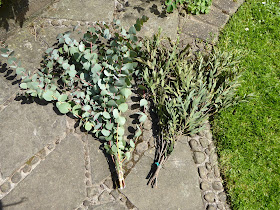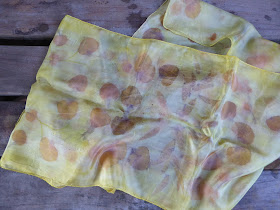Last April, I happened to see some bunches of eucalyptus on sale outside a florist shop. The owner explained that these were last stocks she expected to have until August, as the eucalyptus supply for the UK is grown in Madeira and Italy, where they leave the trees to grow new foliage for a few months after Easter. I bought one bunch of parvifolia, which is narrow leaved and another with pairs of rounded leaves, called cinerea.
I've read Australian bloggers describing hundreds of types of eucalyptus with widely differing dye potential, so I knew it would be a stab in the dark to have a go at dyeing with random species grown in the Northern Hemisphere. It does seem true that trees grown in the UK don't get enough sun to develop orange dye, as I only had green prints from a local eucalyptus.
I finally got round to making contact dye bundles at the beginning of June, when a few weld plants had shot up flower spikes that wanted harvesting. None of the other garden dye plants were flowering, so I soaked some of the dried eucalyptus in hot water, to make the brittle leaves and stalks flexible, before laying them out on some fine wool fabric together with the weld spikes.
Some of the weld was was dipped in iron solution and some in copper. The fabric was laid out on a strip of greaseproof paper to stop dye going through the layers and another layer of alum mordanted wool was laid on top, sandwiching the plants. All the layers were rolled around a section of plastic drainpipe and bound with string before simmering for an hour or so in a dye bath of dried coreopsis.
I left the bundle to soak overnight and dry out for a couple of days before unrolling, when I was astonished to see how well the two kinds of eucalyptus had printed on both the fabric above and the fabric below them. Once the two wool scarves had dried for a week and had a wash and iron, the eucalyptus prints still looked deep orange.
My companion, Elinor Gotland, trailed a dismissive hoof over the fabric.
"Why on earth aren't you using silk, Beaut? Strapped for cash this month?"
"Actually, Elinor, this fine wool gauze cost more per metre than Habotai. Anyway, I hardly have any left of the silk scarves that Mum hemmed for me."
"Well, her hard work is doing no-one any good sitting in a drawer. Get some silk out and use eucalyptus on it, can't go wrong with prints like these."
Privately, I had misgivings. I haven't used eucalyptus much, but past results on alum mordanted silk have been less spectacular. Following online discussions, I've noticed people often talk about adding rusty nails, spraying vinegar onto ecobundles and steaming them for several hours. I've found rust makes very black marks, almost burning holes in silk. Steaming isn't going to reach as high a temperature as boiling, maybe that stops the rust from being so savage. I may have a proper go at it eventually.
For the moment, I decided to try soaking some of the dried eucalyptus leaves for half an hour in plain hot water, some in hot water with vinegar and some in hot water with both vinegar and iron solution added, just to see if one might make better prints. This silk was folded in half lengthwise over the leaves together with some Dyers Chamomile flowers.
Of course, once I unwrapped it, I had no idea which leaves had been soaked in which jar. The prints were much paler than on wool and I reckon the darker, browner ones must have been soaked with iron, though there isn't a marked difference to show which had vinegar and which did not.
In the meantime, I had used the same three soaks for leaves rolled in a cotton shirt, mordanted with aluminium acetate. The prints they made are much dimmer than those on wool and far less dramatic than the colours from weld dipped in iron, coreopsis flowers or madder roots.
Again, I'd guess the darker eucalyptus prints with lots of little grey dots had had an iron soak. Hoping to get a clear idea of what was really happening, I made another roll with two wool scarves. This time, at the top end of the scarf sandwich, shown centrally in the photo, I put three cinerea leaves from a hot water soak, then three from hot water and vinegar, then three from hot water, vinegar and iron. After that, a circle of parvifolia leaves, with hot water from 12 o' clock to 4 o' clock, vinegar from 4 o' clock to 8 o'clock and vinegar with iron from 8 o'clock up to 12 o'clock. This roll was simmered in an afterbath of weld leaves with iron, to colour the borders.
I am not convinced that adding vinegar made any difference to the prints from either of these two types of eucalyptus leaf, whether on wool, silk or cotton. Adding iron made the paler prints on silk and cotton stand out more at the expense of saddening the colour, while on wool, any effect of iron appears marginal.
"I still have plenty of dried eucalyptus leaves left and I think I'll save them for printing on wool, whatever you say, Elinor."
My companion judged the dye results by her own criteria and took command of the situation.
"I shall take care of this silk, since you don't appreciate it. It's what your mother would have wanted."
I've read Australian bloggers describing hundreds of types of eucalyptus with widely differing dye potential, so I knew it would be a stab in the dark to have a go at dyeing with random species grown in the Northern Hemisphere. It does seem true that trees grown in the UK don't get enough sun to develop orange dye, as I only had green prints from a local eucalyptus.
I finally got round to making contact dye bundles at the beginning of June, when a few weld plants had shot up flower spikes that wanted harvesting. None of the other garden dye plants were flowering, so I soaked some of the dried eucalyptus in hot water, to make the brittle leaves and stalks flexible, before laying them out on some fine wool fabric together with the weld spikes.
Some of the weld was was dipped in iron solution and some in copper. The fabric was laid out on a strip of greaseproof paper to stop dye going through the layers and another layer of alum mordanted wool was laid on top, sandwiching the plants. All the layers were rolled around a section of plastic drainpipe and bound with string before simmering for an hour or so in a dye bath of dried coreopsis.
"Why on earth aren't you using silk, Beaut? Strapped for cash this month?"
"Actually, Elinor, this fine wool gauze cost more per metre than Habotai. Anyway, I hardly have any left of the silk scarves that Mum hemmed for me."
"Well, her hard work is doing no-one any good sitting in a drawer. Get some silk out and use eucalyptus on it, can't go wrong with prints like these."
Privately, I had misgivings. I haven't used eucalyptus much, but past results on alum mordanted silk have been less spectacular. Following online discussions, I've noticed people often talk about adding rusty nails, spraying vinegar onto ecobundles and steaming them for several hours. I've found rust makes very black marks, almost burning holes in silk. Steaming isn't going to reach as high a temperature as boiling, maybe that stops the rust from being so savage. I may have a proper go at it eventually.
For the moment, I decided to try soaking some of the dried eucalyptus leaves for half an hour in plain hot water, some in hot water with vinegar and some in hot water with both vinegar and iron solution added, just to see if one might make better prints. This silk was folded in half lengthwise over the leaves together with some Dyers Chamomile flowers.
Of course, once I unwrapped it, I had no idea which leaves had been soaked in which jar. The prints were much paler than on wool and I reckon the darker, browner ones must have been soaked with iron, though there isn't a marked difference to show which had vinegar and which did not.
In the meantime, I had used the same three soaks for leaves rolled in a cotton shirt, mordanted with aluminium acetate. The prints they made are much dimmer than those on wool and far less dramatic than the colours from weld dipped in iron, coreopsis flowers or madder roots.
Again, I'd guess the darker eucalyptus prints with lots of little grey dots had had an iron soak. Hoping to get a clear idea of what was really happening, I made another roll with two wool scarves. This time, at the top end of the scarf sandwich, shown centrally in the photo, I put three cinerea leaves from a hot water soak, then three from hot water and vinegar, then three from hot water, vinegar and iron. After that, a circle of parvifolia leaves, with hot water from 12 o' clock to 4 o' clock, vinegar from 4 o' clock to 8 o'clock and vinegar with iron from 8 o'clock up to 12 o'clock. This roll was simmered in an afterbath of weld leaves with iron, to colour the borders.
I am not convinced that adding vinegar made any difference to the prints from either of these two types of eucalyptus leaf, whether on wool, silk or cotton. Adding iron made the paler prints on silk and cotton stand out more at the expense of saddening the colour, while on wool, any effect of iron appears marginal.
"I still have plenty of dried eucalyptus leaves left and I think I'll save them for printing on wool, whatever you say, Elinor."
My companion judged the dye results by her own criteria and took command of the situation.
"I shall take care of this silk, since you don't appreciate it. It's what your mother would have wanted."











Incredibly beautiful...
ReplyDeleteThank you :)
Deleteha, that's an easy way to get an new silk scarf:) anyway, the prints are lovely! have you ever thought about using the fine roots of galium verum to do red prints like that? it's flowering everywhere right now, but it's next to impossible to get out with intact roots, because most of it grows into our stone walls:( I think DH and our neighbours might get a bit upset if I started to take them apart for some roots:)I will put up a few solar jars with old dahlias and two bags full of frozen aquilegia flowers instead.... with this heat it might even work for once!
ReplyDeleteI haven't looked for galium verum or tried to grow my own - sounds like I should, thanks :)
ReplyDeletelovely!
ReplyDeleteThanks - the leaf shapes are really pretty :)
Deletestunning work! I love to dye things
ReplyDeleteIt has all the excitement of triumph and disaster - I love it too :)
DeleteThank a lot for this post that was very interesting. Keep posting like those amazing posts, this is really awesome :)
ReplyDeleteLooking for Custom T-shirt Printing in Navi Mumbai, visit on:
T-shirt Printing